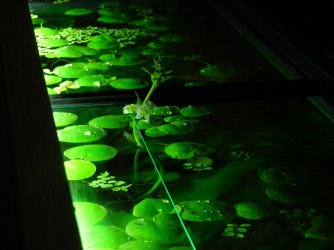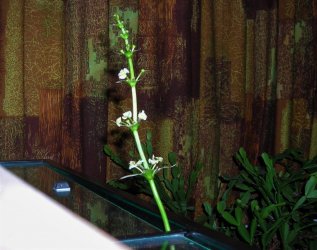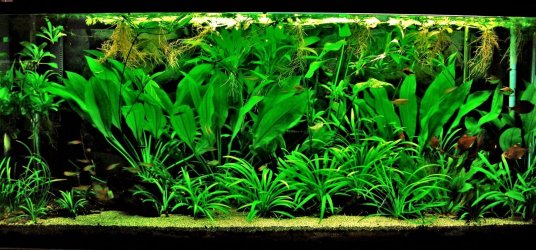How do i root these? Step by step, never had sword babies before…

You are using an out of date browser. It may not display this or other websites correctly.
You should upgrade or use an alternative browser.
You should upgrade or use an alternative browser.
Amazon sword baby
- Thread starter Sgooosh
- Start date
PorshaF
Fish Crazy
Omgosh how precious, I can't wait until mine do too. From what I've read they eventually grow their own root system, perhaps there is another way though to separate them now. Waiting to see what someone else advices! Congrats on being a sword grandparent haha
Thank youOmgosh how precious, I can't wait until mine do too. From what I've read they eventually grow their own root system, perhaps there is another way though to separate them now. Waiting to see what someone else advices! Congrats on being a sword grandparent haha
Its summer where i am, they start to flower when it is summer for me
If your sword is small it may not flower, like my pther sword
PorshaF
Fish Crazy
My biggest ones are only like 8 inches I think, I do have a bunch. I just finished switching my small community tank from silk plants to swords (still need floating plants, I gave them all to the bettas) I put 16 swords in this 30gal, but no flowers for me yet 

WhistlingBadger
Professional Cat Herder
Retired Moderator ⚒️
Tank of the Month 🏆
Fish of the Month 🌟
- Joined
- Dec 18, 2011
- Messages
- 6,992
- Reaction score
- 12,950
- Location
- Where the deer and the antelope play
Let them grow for a while yet. Once they have some good roots going, snip them loose and plant them. Simple as that!
The top one has a long root, is that enugg or more?Let them grow for a while yet. Once they have some good roots going, snip them loose and plant them. Simple as that!
How do you keep algae levels low?My biggest ones are only like 8 inches I think, I do have a bunch. I just finished switching my small community tank from silk plants to swords (still need floating plants, I gave them all to the bettas) I put 16 swords in this 30gal, but no flowers for me yetView attachment 138006
You have to wqit a while
PorshaF
Fish Crazy
I manually clean the front glass once every month, the lights on a timer in this tank, it's my dining room. So the tank light is on 8 hours then room light stays on 2 hours after the led is off, then I turn the room light off after we last eat. I've actually not had any algae in this tank except for black beard on the wood and it seems okay right now. Sometimes I take the wood out and clean it with tank water and a toothbrush if the algae is too visible. But I also have bladder snails in almost every one of my tanks, I think I accidentally spread them with the gravel vaccum or something hahaHow do you keep algae levels low?
You have to wqit a while
WhistlingBadger
Professional Cat Herder
Retired Moderator ⚒️
Tank of the Month 🏆
Fish of the Month 🌟
- Joined
- Dec 18, 2011
- Messages
- 6,992
- Reaction score
- 12,950
- Location
- Where the deer and the antelope play
I'd let it grow a while yet. They'll grow to almost full-size while attached to the parent plant. You could probably replant it now if you need to, but I like to let them get a good bit bigger. There isn't a set time or size to replant.The top one has a long root, is that enugg or more?
Uberhoust
Fish Herder
I am totally jealous. Obvious your swords are doing well.
I agree with others to let the adventitious plants develop further roots before removing. You will note there are two adventitious plants (baby or daughter plants) at each node on the inflorescence; you can remove these by gently pulling the adventitious plant backwards. You can plant them individually or together for a bushier plant. Once the adventitious plants have leaves and roots, they are no longer deriving any nutrient via the inflorescence, so you can remove them and plant, or leave them. The problem with leaving them is usually algae, I have always had the adventitious plants left on the inflorescence develop brush algae.
Someone mentioned flowering...with one possible exception, you will not get flowers from Echinodorus sword plants when grown submersed. The plant in the photos is E. grisebachii, var. bleherae, though it is likely still being offered as "Echnodorus bleherae" [see explanation below]. As with the majority of species in this genus, E. grisebachii is a bog (marsh) plant in nature, spending half the year emersed (during which it flowers) and half submersed. The “bleherae” variant prefers to grow submersed and therefore adapts well to fully-submersed conditions and is thus an excellent aquarium plant. Aquatic leaves will be quite different from emersed leaves, in shape, size and texture.
According to botanists, only E. major will flower when grown submersed. I have this plant, and it has flowered twice in the last decade. Photo below is of the flower, which is similar to the flowers of all species. Third photo shows the many adventitious plants growing from the parent E. grisebachii plants.
On a taxonomic note...This plant was originally described as a distinct species, Echinodorus bleheri (Rataj, 1970), and the name was subsequently corrected by Dr. Rataj to E. bleherae (the feminine gender); it was named in honour of Amanda Bleher (mother of Heiko) who first exported it from Brazil over 40 years ago. This is no longer deemed to be a distinct species botanically. Confusion has existed for the past few decades over the number of species in the genus Echinodorus, and many have been known under different names. In his earlier study of the genus, Rataj (1975) listed 47 species. A major revision by the botanists R.R. Haynes and L.B. Holm-Nielsen (1994) listed 26 species. In his 2004 revision, Rataj increased the number of species to 62. More recent work by Samuli Lehtonen—incorporating phylogenetic (DNA) analysis—proposed 28 valid species (Lehtonen, 2007). As of 2013, The Plant List and the World Checklist of Selected Plant Families (maintained by Kew) have 30 distinct species listed for Echinodorus.
Haynes & Holm-Nielsen (1994) considered the species E. bleherae, E. amazonicus and E. parviflorus to be conspecific [the same species] with E. grisebachii. Kasselmann (2002) suggested that the different habitus of the submersed plants between these three "species" is reason to retain the present names in the hobby. But Lehtonen's extensive phylogenetic analysis (2006) basically supports the findings of Haynes & Holm-Nielsen, with a few changes, and this classification is now accepted. The former “species” that are now deemed to be within the one polymorphic species E. grisebachii are Echinodorus amazonicus, Echinodorus amazonicus var. parviflorus, Echinodorus amphibius, Echinodorus bleherae, Echinodorus eglandulosus, Echinodorus gracilis, Echinodorus grisebachii var. minor, and Echinodorus parviflorus. These names are now synonymous with E. grisebachii.
Differences in appearance between these plants are apparent and seem dependent on the specific environment in the aquarium; this seems likely to also occur in nature, what can be termed transitional forms of the species. But the limited genetic variation within the complex is insufficient to establish reasonable groupings (Lehtonen & Falck, 2011).
This species epithet grisebachii takes precedence over the others under the rules of the International Code of Botanical Nomenclature because it was the first name assigned to the species, and this was by the American botanist j.k. Small in 1909; the name honours the German botanist H.R.A. Grisebach (1814-1879).
Someone mentioned flowering...with one possible exception, you will not get flowers from Echinodorus sword plants when grown submersed. The plant in the photos is E. grisebachii, var. bleherae, though it is likely still being offered as "Echnodorus bleherae" [see explanation below]. As with the majority of species in this genus, E. grisebachii is a bog (marsh) plant in nature, spending half the year emersed (during which it flowers) and half submersed. The “bleherae” variant prefers to grow submersed and therefore adapts well to fully-submersed conditions and is thus an excellent aquarium plant. Aquatic leaves will be quite different from emersed leaves, in shape, size and texture.
According to botanists, only E. major will flower when grown submersed. I have this plant, and it has flowered twice in the last decade. Photo below is of the flower, which is similar to the flowers of all species. Third photo shows the many adventitious plants growing from the parent E. grisebachii plants.
On a taxonomic note...This plant was originally described as a distinct species, Echinodorus bleheri (Rataj, 1970), and the name was subsequently corrected by Dr. Rataj to E. bleherae (the feminine gender); it was named in honour of Amanda Bleher (mother of Heiko) who first exported it from Brazil over 40 years ago. This is no longer deemed to be a distinct species botanically. Confusion has existed for the past few decades over the number of species in the genus Echinodorus, and many have been known under different names. In his earlier study of the genus, Rataj (1975) listed 47 species. A major revision by the botanists R.R. Haynes and L.B. Holm-Nielsen (1994) listed 26 species. In his 2004 revision, Rataj increased the number of species to 62. More recent work by Samuli Lehtonen—incorporating phylogenetic (DNA) analysis—proposed 28 valid species (Lehtonen, 2007). As of 2013, The Plant List and the World Checklist of Selected Plant Families (maintained by Kew) have 30 distinct species listed for Echinodorus.
Haynes & Holm-Nielsen (1994) considered the species E. bleherae, E. amazonicus and E. parviflorus to be conspecific [the same species] with E. grisebachii. Kasselmann (2002) suggested that the different habitus of the submersed plants between these three "species" is reason to retain the present names in the hobby. But Lehtonen's extensive phylogenetic analysis (2006) basically supports the findings of Haynes & Holm-Nielsen, with a few changes, and this classification is now accepted. The former “species” that are now deemed to be within the one polymorphic species E. grisebachii are Echinodorus amazonicus, Echinodorus amazonicus var. parviflorus, Echinodorus amphibius, Echinodorus bleherae, Echinodorus eglandulosus, Echinodorus gracilis, Echinodorus grisebachii var. minor, and Echinodorus parviflorus. These names are now synonymous with E. grisebachii.
Differences in appearance between these plants are apparent and seem dependent on the specific environment in the aquarium; this seems likely to also occur in nature, what can be termed transitional forms of the species. But the limited genetic variation within the complex is insufficient to establish reasonable groupings (Lehtonen & Falck, 2011).
This species epithet grisebachii takes precedence over the others under the rules of the International Code of Botanical Nomenclature because it was the first name assigned to the species, and this was by the American botanist j.k. Small in 1909; the name honours the German botanist H.R.A. Grisebach (1814-1879).
Attachments
Thsnk u!! I never had a plant grow this well!!!I am totally jealous. Obvious your swords are doing well.
Hipe yours will also flower!!
Yes, thanks, i have another question to y’allI agree with others to let the adventitious plants develop further roots before removing. You will note there are two adventitious plants (baby or daughter plants) at each node on the inflorescence; you can remove these by gently pulling the adventitious plant backwards. You can plant them individually or together for a bushier plant. Once the adventitious plants have leaves and roots, they are no longer deriving any nutrient via the inflorescence, so you can remove them and plant, or leave them. The problem with leaving them is usually algae, I have always had the adventitious plants left on the inflorescence develop brush algae.
Someone mentioned flowering...with one possible exception, you will not get flowers from Echinodorus sword plants when grown submersed. The plant in the photos is E. grisebachii, var. bleherae, though it is likely still being offered as "Echnodorus bleherae" [see explanation below]. As with the majority of species in this genus, E. grisebachii is a bog (marsh) plant in nature, spending half the year emersed (during which it flowers) and half submersed. The “bleherae” variant prefers to grow submersed and therefore adapts well to fully-submersed conditions and is thus an excellent aquarium plant. Aquatic leaves will be quite different from emersed leaves, in shape, size and texture.
According to botanists, only E. major will flower when grown submersed. I have this plant, and it has flowered twice in the last decade. Photo below is of the flower, which is similar to the flowers of all species. Third photo shows the many adventitious plants growing from the parent E. grisebachii plants.
On a taxonomic note...This plant was originally described as a distinct species, Echinodorus bleheri (Rataj, 1970), and the name was subsequently corrected by Dr. Rataj to E. bleherae (the feminine gender); it was named in honour of Amanda Bleher (mother of Heiko) who first exported it from Brazil over 40 years ago. This is no longer deemed to be a distinct species botanically. Confusion has existed for the past few decades over the number of species in the genus Echinodorus, and many have been known under different names. In his earlier study of the genus, Rataj (1975) listed 47 species. A major revision by the botanists R.R. Haynes and L.B. Holm-Nielsen (1994) listed 26 species. In his 2004 revision, Rataj increased the number of species to 62. More recent work by Samuli Lehtonen—incorporating phylogenetic (DNA) analysis—proposed 28 valid species (Lehtonen, 2007). As of 2013, The Plant List and the World Checklist of Selected Plant Families (maintained by Kew) have 30 distinct species listed for Echinodorus.
Haynes & Holm-Nielsen (1994) considered the species E. bleherae, E. amazonicus and E. parviflorus to be conspecific [the same species] with E. grisebachii. Kasselmann (2002) suggested that the different habitus of the submersed plants between these three "species" is reason to retain the present names in the hobby. But Lehtonen's extensive phylogenetic analysis (2006) basically supports the findings of Haynes & Holm-Nielsen, with a few changes, and this classification is now accepted. The former “species” that are now deemed to be within the one polymorphic species E. grisebachii are Echinodorus amazonicus, Echinodorus amazonicus var. parviflorus, Echinodorus amphibius, Echinodorus bleherae, Echinodorus eglandulosus, Echinodorus gracilis, Echinodorus grisebachii var. minor, and Echinodorus parviflorus. These names are now synonymous with E. grisebachii.
Differences in appearance between these plants are apparent and seem dependent on the specific environment in the aquarium; this seems likely to also occur in nature, what can be termed transitional forms of the species. But the limited genetic variation within the complex is insufficient to establish reasonable groupings (Lehtonen & Falck, 2011).
This species epithet grisebachii takes precedence over the others under the rules of the International Code of Botanical Nomenclature because it was the first name assigned to the species, and this was by the American botanist j.k. Small in 1909; the name honours the German botanist H.R.A. Grisebach (1814-1879).
Sorry im on phone you ca tell by my bad spelling
If you are referring to the Pennywort, it would do better in a brighter location in the tank. Stem plants are fast growing plants, and while Pennywort does seem to do well with less bright light than most demand, it is still relatively fast growing. It grows well left floating on the surface too.
Similar threads
- Replies
- 18
- Views
- 952




